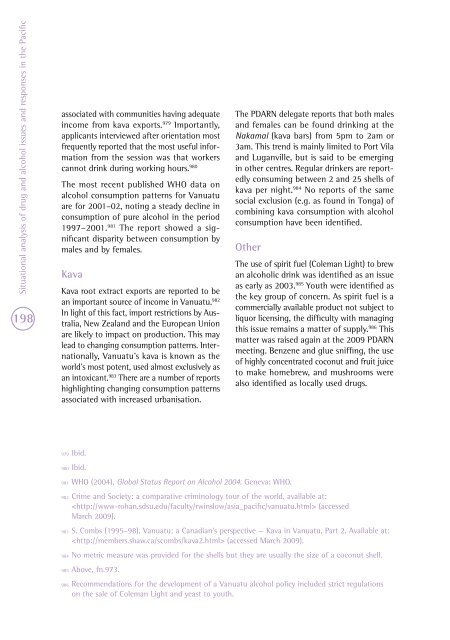rp21 situational analysis - Pacific Health Voices
rp21 situational analysis - Pacific Health Voices
rp21 situational analysis - Pacific Health Voices
Create successful ePaper yourself
Turn your PDF publications into a flip-book with our unique Google optimized e-Paper software.
Situational <strong>analysis</strong> of drug and alcohol issues and responses in the <strong>Pacific</strong><br />
198<br />
associated with communities having adequate<br />
income from kava exports. 979 Importantly,<br />
applicants interviewed after orientation most<br />
frequently reported that the most useful information<br />
from the session was that workers<br />
cannot drink during working hours. 980<br />
The most recent published WHO data on<br />
alcohol consumption patterns for Vanuatu<br />
are for 2001–02, noting a steady decline in<br />
consumption of pure alcohol in the period<br />
1997–2001. 981 The report showed a significant<br />
disparity between consumption by<br />
males and by females.<br />
Kava<br />
Kava root extract exports are reported to be<br />
an important source of income in Vanuatu. 982<br />
In light of this fact, import restrictions by Australia,<br />
New Zealand and the European Union<br />
are likely to impact on production. This may<br />
lead to changing consumption patterns. Internationally,<br />
Vanuatu’s kava is known as the<br />
world’s most potent, used almost exclusively as<br />
an intoxicant. 983 There are a number of reports<br />
highlighting changing consumption patterns<br />
associated with increased urbanisation.<br />
The PDARN delegate reports that both males<br />
and females can be found drinking at the<br />
Nakamal (kava bars) from 5pm to 2am or<br />
3am. This trend is mainly limited to Port Vila<br />
and Luganville, but is said to be emerging<br />
in other centres. Regular drinkers are reportedly<br />
consuming between 2 and 25 shells of<br />
kava per night. 984 No reports of the same<br />
social exclusion (e.g. as found in Tonga) of<br />
combining kava consumption with alcohol<br />
consumption have been identified.<br />
Other<br />
The use of spirit fuel (Coleman Light) to brew<br />
an alcoholic drink was identified as an issue<br />
as early as 2003. 985 Youth were identified as<br />
the key group of concern. As spirit fuel is a<br />
commercially available product not subject to<br />
liquor licensing, the difficulty with managing<br />
this issue remains a matter of supply. 986 This<br />
matter was raised again at the 2009 PDARN<br />
meeting. Benzene and glue sniffing, the use<br />
of highly concentrated coconut and fruit juice<br />
to make homebrew, and mushrooms were<br />
also identified as locally used drugs.<br />
979 Ibid.<br />
980 Ibid.<br />
981 WHO (2004), Global Status Report on Alcohol 2004. Geneva: WHO.<br />
982 Crime and Society: a comparative criminology tour of the world, available at:<br />
(accessed<br />
March 2009).<br />
983 S. Combs (1995–98), Vanuatu: a Canadian’s perspective — Kava in Vanuatu, Part 2. Available at:<br />
(accessed March 2009).<br />
984 No metric measure was provided for the shells but they are usually the size of a coconut shell.<br />
985 Above, fn.973.<br />
986 Recommendations for the development of a Vanuatu alcohol policy included strict regulations<br />
on the sale of Coleman Light and yeast to youth.
















